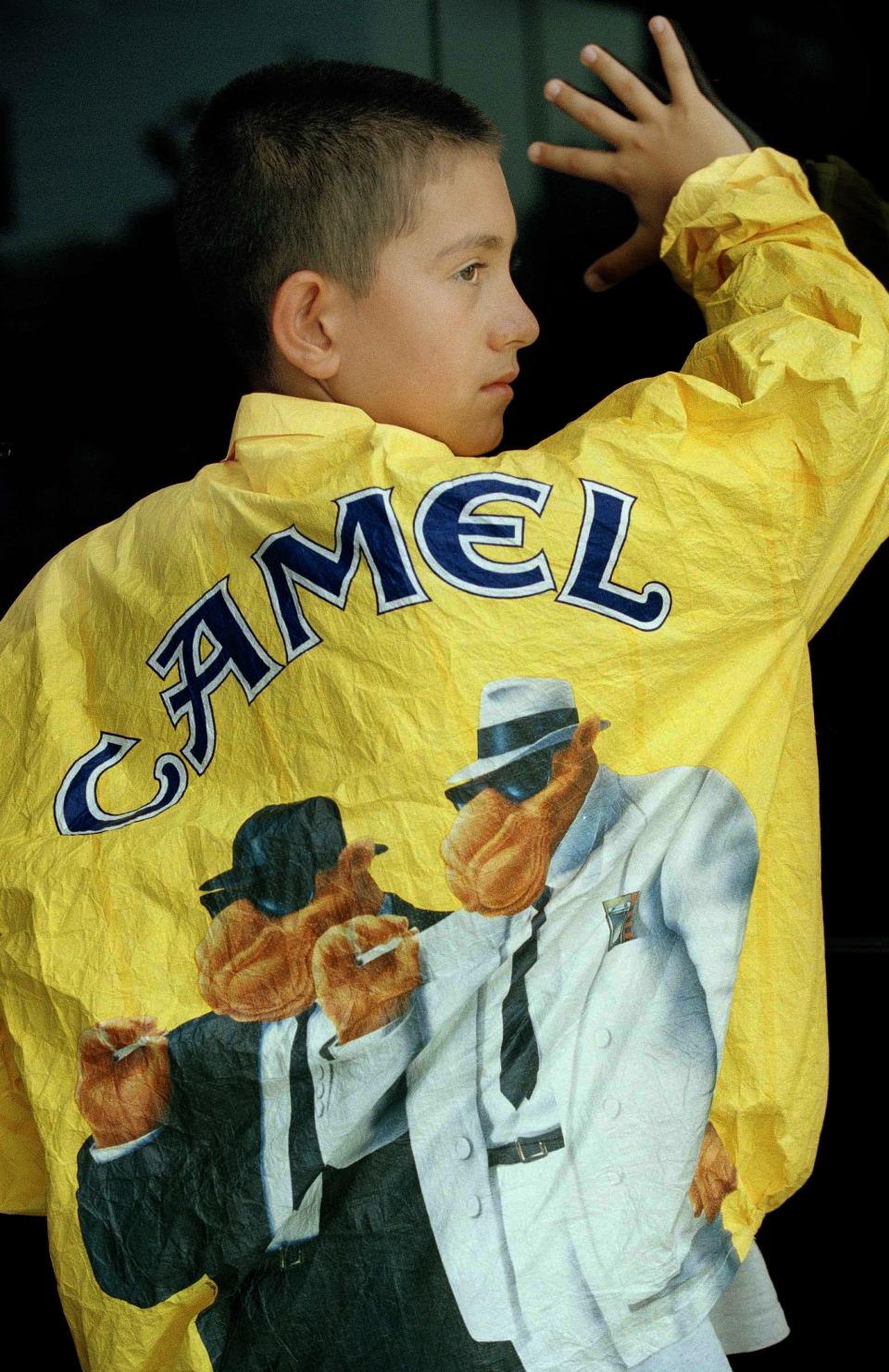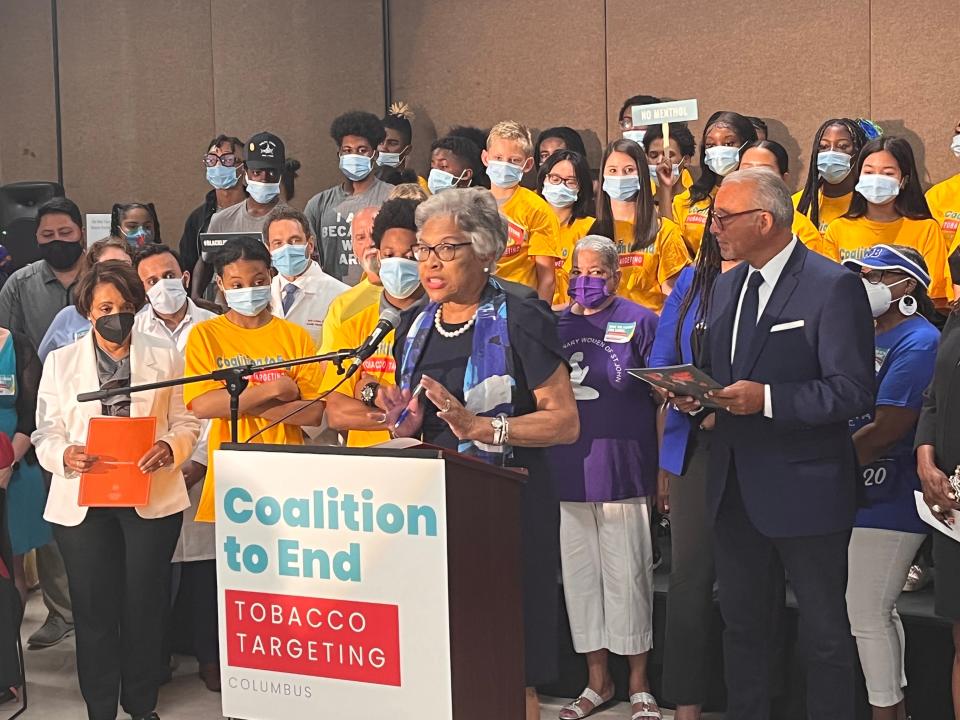Our view: City must spoil sinister ploy. Ban flavored vaping tobacco, menthol cigarettes.
- Oops!Something went wrong.Please try again later.
Joe Camel — R. J. Reynolds Tobacco Company's smirking, saxophone-playing cartoon advertising creation — took his last puff in 1997 after taking heat from then-President Bill Clinton and a long list of others who spotted what was really behind those dark shades: a ploy to hook a new generation of consumers by convincing kids that smoking is fun and cool.
As sinister as it clearly was, the campaign was working before Joe Camel went up in flames.
The Federal Trade Commission charged that R.J. Reynolds "was successful in appealing to many children and adolescents under 18, induced many young people to begin smoking or to continue smoking cigarettes and as a result caused significant injury to their health and safety. "

A 1991 Journal of the American Medical Association study found that 91% of six-year-olds could correctly connect an image of bad boy Joe to the products he sold: cigarettes.
Dig Deeper:Kids around world now recognize cigarette brand logos
An almost equal number of 6-year-olds linked Mickey Mouse with Disney.
Targeting efforts didn't stop with Joe Camel's face
Joe hung up his shades, but the tobacco industry never gave up on its attempts to lure in nearly life-long customers, particularly Black, brown, and economically disadvantaged youth.
This is illustrated by maps developed by Ice Miller LLP as part of a study that exposes tobacco retailers' predatory practices here in Columbus that use flavored e-cigarettes (vaping) and menthol products that have for decades targeted Black people.
The Coalition to End Tobacco Targeting, an organization that represents 125 greater Columbus community organizations, public health advocacy agencies and faith institutions, is asking the city to pass legislation that would ban the sale of menthol cigarettes and all flavored tobacco products.
It would be legal for people to use and possess the products, but they could not be legally sold by Columbus retailers.
Columbus Public Health, the agency that would be tasked with enforcing the ban at retailers, is working with the coalition and exploring options, a spokeswoman says.
There are clear reasons why city council should ban the sale of flavored tobacco and menthol cigarettes.
Traps are set to draw kids
Retailers of all sorts naturally flock to areas such as High Street to cater to the economically advantaged.
But for businesses peddling tobacco products, the most economically challenged sectors of our community seem so much more appealing.
Colorful window signs literally lure kids with tobacco made to taste like candy.
More:Angel: Big tobacco industry luring Black teens to death with candy-flavored e-cigarettes
For example, there area eight tobacco retailers within a quarter of a mile of Champion Middle School and 13 places selling the flashy products within a half mile of South High School, Ice Miller found.
"It would be hard to go to school without running into one of these retailers," Chris Magill, the law firm's economic development director, told us.
There are 863 tobacco retailers within the city of Columbus' 226 square miles. Ice Miller found that aside from High Street, the bulk are concentrated in low-income neighborhoods that have a Black population above 25%. Many of these areas have the city's highest cases of chronic illnesses such as asthma, COPD, and diabetes.
This includes 77 in the 15.5 square mile Hilltop neighborhood; 42 in the 4.91 square mile North Linden; 54 in 7.07 square mile Southside and 22 in 10.6 square mile Franklinton.
The 1.09 square mile Livingston Avenue area with an average household income of $35,000 had 15 tobacco retail locations. That area is bordered by Livingston, Whittier Street, Dwight D. Eisenhower Memorial Highway and to just before Grant Street.
This compares to 23 tobacco sellers in the 6.14 square miles of Clintonville which has an average household income of $97,000 and 16 retailers in 11.3 square miles of West Scioto, which has an average household income of $85,000.
More:Coalition to End Tobacco Targeting calls on city to end sale of flavored tobacco products
Columbus must take action
The Coalition to End Tobacco Targeting is supported by a list of leaders that include former Columbus Mayor Michael B. Coleman, Ice Miller's partner in charge of government law; Congresswoman Joyce Beatty; Columbus Urban League President and CEO Stephanie Hightower; Christie Angel, president and CEO of YWCA Columbus, Ohio Rep. Dontavius Jarrells, D-Columbus; and Columbus City Council President Pro Tempore Elizabeth Brown.
Michael Coleman: 'I thought smoking was cool.' Menthols nearly took life, ban sell it here
The city of Columbus declared racism a public health crisis in 2020. There are fewer clear examples of orchestrated health disparities than this.
The Dispatch Editorial Board joins the call to ban the sale of flavored tobacco and menthol cigarettes.
These products send people of all races to earlier graves, but companies and retailers aggressively target members of the Black and brown communities, taking advantage of vulnerabilities to secure profits.
More:What's been done to combat racism as a public health crisis in Columbus?
The city would not be alone in doing so, but would lead the way in Ohio. Tobacco Free Kids says 160 communities around the nation restrict the sale of menthol cigarettes and other flavored tobacco products used for vaping. In 2019, Massachusetts became the first state to restrict the sale of all flavored tobacco.
The following year, New York, Rhode Island, and New Jersey banned the sale of flavored e-cigarette product. California outlawed the sale of both flavored e-cigarettes and menthol cigarettes in 2020, but a referendum vote that may overturn the law is on the ballot in November

A matter of life or death
Targeting Black people is nothing new and it is one of the reasons the FDA proposed rules in April that would prohibit the sale of flavored cigars and cigarettes with menthol, an additive that has a minty taste and aroma that "reduces the irritation and harshness of smoking."
According to the FDA, nearly 85% of all non-Hispanic Black smokers use menthol cigarettes. This compares to 30% of non-Hispanic white smokers.
The 2021 report "Stopping Menthol, Saving Lives" says that less than 10% of Black smokers used menthol cigarettes in 1950.
Due to aggressive advertising, promotions, pricing and availability today 85% of Black smokers use menthol cigarettes.
Black people accounted for 40% of deaths due to menthol cigarette smoking between 1980 and 2018, despite the fact that Black people make up only about 12% of this nation's population, according to the The Centers for Disease Control.
A study cited by the FDA estimated a 15% reduction in smoking within 40 years if menthol cigarettes were no longer available in the U.S.
Between 2011 to 2018, menthol cigarette use declined for non-Hispanic white youth but not for Hispanic or non-Hispanic Black youth, the agency says.
Vaping appeals to kids
Just as with Joe Camel, it is no mistake that candy-colored packaging and advertising is used to attract kids to flavored tobacco. Citing studies published by the Journal of the American Medical Association, Tobacco Free Kids says at least 66% of youth smokers use tobacco products “because they come in flavors I like” and half who have ever smoked started with menthol cigarettes.
The CDC reports that in 2021, eight out of 10 middle and high school tobacco users said they had a flavored tobacco product in the past month.
It is no mistake the products taste like cotton candy, bubble gum, clove, fruit, mint and chocolate.
The tobacco company knows how to lure kids to the flame.
Columbus should ban flavored tobacco and menthol cigarettes to ensure fewer are burned by years of nicotine addiction and the health problems that often come with it.
What do you think?
Should the sale of flavored vaping tobacco and menthol cigarettes be banned in Columbus? Let's us know in a letter to the editor emailed to Letters@Dispatch.com.
This piece was written by the Dispatch Opinion Editor Amelia Robinson on behalf of The Dispatch Editorial Board. Editorials are our board's fact-based assessment of issues of importance to the communities we serve. These are not the opinions of our reporting staff members, who strive for neutrality in their reporting.
This article originally appeared on The Columbus Dispatch: Editorial: Columbus City Council ban flavored vaping and menthol products

